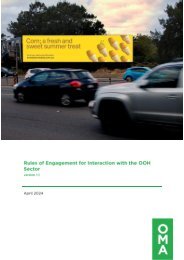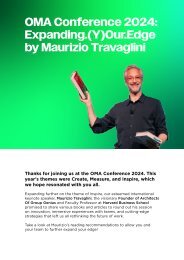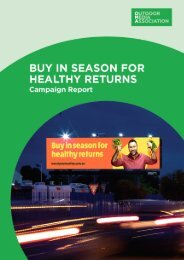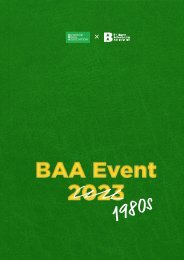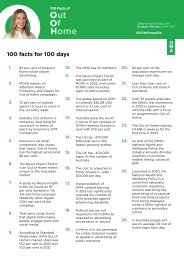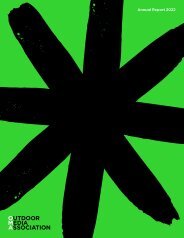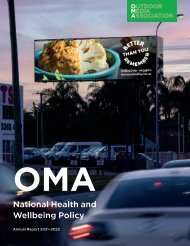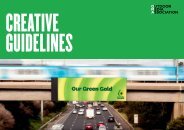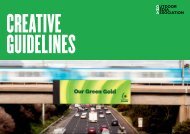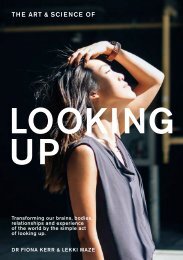OPEN 2
The OPEN series was born from the desire to create a forum for applauding and interrogating strong creative design within the Out of Home (OOH) industry. Illustrating how OOH is part of our cityscape, our commute, our weekend and our shopping and holiday experiences, OOH is ‘the original tweet’ and it cannot be switched off, ignored or fast forwarded. Big, bold, cheeky, simple, clever and controversial, OOH is the ultimate creative stage, allowing brands to be unique, contextually relevant and targeted while reaching mass audiences.
The OPEN series was born from the desire to create a forum for applauding and interrogating strong creative design within the Out of Home (OOH) industry. Illustrating how OOH is part of our cityscape, our commute, our weekend and our shopping and holiday experiences, OOH is ‘the original tweet’ and it cannot be switched off, ignored or fast forwarded. Big, bold, cheeky, simple, clever and controversial, OOH is the ultimate creative stage, allowing brands to be unique, contextually relevant and targeted while reaching mass audiences.
Create successful ePaper yourself
Turn your PDF publications into a flip-book with our unique Google optimized e-Paper software.
FOREWORD<br />
Dr Rebecca Huntley, Executive Director,<br />
Ipsos Mind & Mood Report<br />
...<br />
Last year, my husband and I took our fiveyear-old<br />
daughter to Disneyland in Los<br />
Angeles. Wandering around with a social<br />
researcher’s eye (sure, I was on holiday but<br />
I couldn’t help it) I was struck with how<br />
effective the theme park is as an outdoor<br />
experience. Many of the rides are indoors,<br />
but the magic of Disneyland is the feeling that<br />
you are exploring a terrain, an environment<br />
– albeit artificial. You feel like Alice in<br />
Wonderland, only with fizzy drinks and hot<br />
dogs rather than magical potions and cakes.<br />
The whole Disneyland experience is<br />
mesmerising and, of course, you can’t help but<br />
leave with a heap of merchandise – the rides<br />
feel designed to thrill and lull you into a state<br />
of abandon just as you are funnelled into a gift<br />
shop. But you also leave with a greater respect<br />
for the Disney brand and an appreciation that<br />
Disneyland is in fact the ultimate example<br />
of the power and potential of Out-of-Home<br />
(OOH) advertising.<br />
Reviewing the creative collated for<br />
<strong>OPEN</strong> 2 – the best examples of OOH from<br />
Australia and around the world – reinforces for<br />
me what’s inspiring and really working for this<br />
media channel. The key themes reflect what<br />
Australian consumers expect and want from<br />
advertising: Humour Me, Sell Me Something,<br />
Tell Me a Story and Interact with Me. An<br />
AC Nielsen study from 2011 revealed that 75% of<br />
people agree that OOH gives people something<br />
to look at when out and about, and 78% said it<br />
was useful to have a website address included<br />
on that advertising. 1 The correlation of these<br />
two statistics is that people are expecting more<br />
from OOH; they want it to be entertaining,<br />
engaging and useful. Judging from the<br />
campaigns in <strong>OPEN</strong> 2 , it does not disappoint.<br />
Poring over the different examples of<br />
OOH creative, I am struck again and again by<br />
how the different consumer and social trends<br />
we observe in our research for The Mind &<br />
Mood Report connect with what is happening<br />
and what is being harnessed in this work.<br />
Take, for example, the water-generating,<br />
air-purifying billboards in Peru that provide<br />
clean water and air. Or the flowering bus<br />
shelters in Belgrade reminding people of<br />
the city’s potential for beauty. In recent<br />
research Ipsos conducted into how urban<br />
and regional dwellers feel about their local<br />
environments, residents talked about how<br />
much they appreciated the presence of largescale<br />
art works and sculptures in public places.<br />
Australians want their city and townscapes<br />
to be dynamic, interesting and surprising.<br />
In recent times, OOH has at times been a form<br />
of public art – funny, thought provoking and<br />
beautiful. Consumers are realistic that it can’t<br />
always be taxpayers’ money making these<br />
things happen, and when they find out that<br />
OOH subsidises street furniture and many other<br />
forms of public infrastructure, research has<br />
shown that they look more favourably upon it.<br />
Then there is the notion that OOH, more<br />
than any other advertising channel, can be<br />
useful. Australian consumers talk constantly<br />
about how busy their lives are; fitting<br />
everything they need to do in a day, rushing<br />
from place to place, juggling multiple roles.<br />
They are always looking for aids, tools and tips<br />
to facilitate making their busy lives possible.<br />
But they are also looking for ways to carve<br />
out much-needed respite from all the hubbub.<br />
There are some creative examples in <strong>OPEN</strong> 2<br />
of how OOH can make people’s lives just that<br />
little bit easier. There is the IBM billboard<br />
that doubles as a seat for a weary pedestrian<br />
(pp. 114–115) and one of my personal favourites,<br />
the transit bench in Canada that becomes<br />
a temporary bed for a homeless person (p. 145).<br />
Not only is this serviceable, but it also raises<br />
awareness as well as potential funds for<br />
7 /



